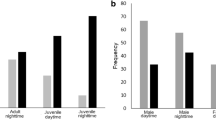Abstract
Scorpions are known to be individualistic animals and of generally aggressive nature that do not interact readily with other individuals even of their own kind. Yet they do share the same habitat with other scorpions of both their own and other species, and are therefore likely to encounter other individuals. An attempt is made to understand how this co-existence is facilitated through behavioural means, in spite of the aggressive nature of scorpions in general. The behavioural interactions of four scorpion species:Scorpio maurus fuscus (Scorpionidae),Nebo hierichonticus (Diplocentridae),Buthotus judaicus andLeiurus quinquestriatus (Buthidae), that share the same habitat in the Mediterranean region of northern Israel: macqui, garrigue and oak woodland, are described. Behavioural patterns observed consisted largely of pedipalp and tail postures that on occasions express threat and even aggressiveness. Both buthids used largely their tails, whereas the scorpionid and diplocentrid used their massive pedipalps for grabbing. Although during much of the time no aggressive behaviours took place, the four species differed significantly in the amount of time allocated to aggressive displays, and in the degree of magnitude reached during aggressive encounters. All four species were significantly more aggressive in interspecific encounters than in intraspecific ones.Leiurus carried out assaults on other species to a significantly greater extent than did other species towards each other, culminating in death of its opponent.
Similar content being viewed by others
References
Newlands, G. 1969 Scorpion defensive behaviour.Afr. Wildl. 23: 147–53.
Palka, J. & K. Sasira Babu 1967 Towards the physiological analysis of defensive responses of scorpions.Z. vergl. Physiol. 55: 286–98.
Stahnke, H.L. 1966 Some aspects of scorpion behavior.Bull. South. Calif. Acad. Sci. 65: 65–80.
Warburg, M.R. 1990 Behavioural patterns of scorpions.Acta Zool. Fenn. 190: 387–92.
Warburg, M.R. 1997 Biogeographic and demographic changes in the distribution and abundance of scorpions inhabiting the Mediterranean region in northern Israel.Biodiversity and Conservation 6: 1377–89.
Warburg, M.R. & A. Ben-Horin 1978 Temperature and humidity effects on scorpion distribution in northern Israel.Proc. Zool. Soc. Lond. 42: 161–9.
Warburg, M.R. & A. Ben-Horin 1979 Thermal effect on the diel activity rhythms of scorpions from mesic and xeric habitats.J. Arid Environ. 2: 339–46.
Warburg, M.R. & R. Elias 1998 The reproductive potential and strategy ofScorpio maurus fuscus (Scorpiones; Scorpionidae); anatomical clues in the ovariuterus.J. Zool. (Lond.) 246: 29–37.
Warburg, M.R., S. Goldenberg & A. Ben-Horin 1980 Scorpion species diversity and distribution within the Mediterranean and arid regions of northern Israel.J. Arid Environ. 3: 205–13.
Warburg, M.R. & G.A. Polis 1990 Behavioral responses, rhythms, and activity patterns. In: G.A. Polis (ed.)The Biology of Scorpions, Stanford University Press, Stanford pp. 224–46.
Author information
Authors and Affiliations
About this article
Cite this article
Warburg, M.R. Qualitative and quantitative analysis of intra-and interspecific behavioural patterns among scorpions. J Ethol 16, 115–121 (1998). https://doi.org/10.1007/BF02769290
Received:
Accepted:
Issue Date:
DOI: https://doi.org/10.1007/BF02769290




